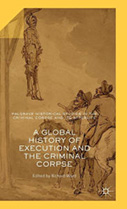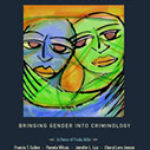A GLOBAL HISTORY OF EXECUTION AND THE CRIMINAL CORPSE

Editor: Richard Ward
Publisher: New York, NY: Palgrave Macmillan, 2015. 313p.
Reviewer: Michael Meranze | January 2017
A Global History of Execution and the Criminal Corpse is a fascinating set of essays that explore not only the socio-political contexts of the death penalty, but also the fate of the condemned after their deaths. Although focused primarily on early modern Europe (especially eighteenth-century England) its reach does extend across the nineteenth-century British Empire and into Asia, Africa, and into the twentieth-century. It will be of interest to scholars of the criminal law, punishment, state-society relations, and the cultural history of death and the body. Given the disparate nature of the essays and the topics they cover there is no single thread of interpretation or argument that emerges. But several themes do appear.
First, the volume makes a compelling case for understanding the death penalty as a political intervention. In essays by James Kelly on eighteenth-century Ireland, and Zoe Dyndor on the gibbeting along the eighteenth-century English coast, it becomes clear that the authorities displayed an acute sense of the virtues of violent display as a response to particular groups who challenged the practice of law and authority. In addition, as essays by Clare Anderson on the nineteenth-century British Empire and Song-Chuan Chen on the international politics of Chinese punishments of Western seamen illustrate, the use and discussion of the death penalty was a powerful symbolic and rhetorical tool in the struggles between empires and nations. Importantly, the essays lay great stress on the historical specificity of the uses of the death penalty; while authorities deployed terror repeatedly and comfortably, they did so with calculations and in pursuit of specific and immediate aims. In this specificity it becomes clear how much executions were particular instruments of government.
The same could be said for the criminal corpse itself. The fate of the corpse is an issue that runs through the entire volume (although with specific intensity in essays by Steve Poole on crime-scene executions, by Alexander Kästner and Evelyne Luef on the punishment of suicide corpses in early modern Germany, and by Caroline Sharples on the debates over the burial of the corpses of Nazi War Criminals). But again, the authors reveal that rather than an inexorable system of penality, the deployment of the death penalty and the treatment of the criminal corpse was a deliberate and debated action. Calculations ran all through the treatment of the punished; just as they did through the nature of the punishment. There was a careful knowledge employed in the use of death and in the debasement of the condemned. Authorities could not act at will. They needed to be aware of local sentiments and customs lest they impose a penalty that would turn the community against them.
Indeed, taken as a whole the essays offer new life to a series of questions that have haunted the history of punishment since the publication of Michel Foucault’s now classic Discipline and Punish (1977), alongside the debates generated from the collective work of Edward Thompson and his students that appeared as Albion’s Fatal Tree (1975). Those two works—albeit in notably different ways and from within different intellectual traditions—insisted upon our understanding the history of punishment as more than simply a system of crime control. Instead, they insisted that punishment was a crucial area for the assertion of both class and state power. A Global History of Execution and the Criminal Corpse does not take up these arguments directly, although in his introduction, Richard Ward does suggest ways to link the essays to larger questions in the historical sociology of the death penalty. Instead, authors offer an extended deliberation on the intersection between the material and the symbolic, or in some cases the symbolic within the material, in the field of the death penalty. By focusing sustained attention on both the particularities of the execution and its scenes (where it was held, what precisely was done to the condemned, what repetitive or ritualized behaviors were enacted, how the scene was constructed) and on the afterlife in the case of the death of a condemned person (was the body gibbeted, where was it buried, who seized the body, to what extent was it polluted or preserved?), the essays present a mosaic of examples of the ways that executions and their aftermaths produced struggles not only over authority but over meaning. To complicate matters further, the nature of those struggles, as Pascal Bastien shows in his discussion of the execution rituals in early modern England, France and Italy, depended on what were regional or national cultures affecting the execution scene.
Perhaps not surprisingly, although the struggle over the legitimacy of executions was important within early modern Europe, it was even more severe in the contexts of imperial expansion. Whether the site was Africa, East and South Asia, or in the Atlantic and Pacific worlds, the tension between metropolitan thinking, imperial realities, and local autonomy meant that the death penalty was highly charged and deeply explosive. Nor was this explosiveness limited to the imperial/colonial relationship. Even in post-colonial societies, the construction of new states that operated in an increasingly interconnected state system found their own power and legitimacy deeply bound up with the practices surrounding the criminal corpse, as Stacey Hynd’s essay on late nineteenth and early twentieth century Africa makes evident. Whereas we tend to think of debates over the death penalty as being primarily about its intrinsic characteristics, historically there has been far more concern about the justice of specific instances of its deployment and the specific forms it has taken. These issues were especially vexed when there was not even a shared culture of executions or the treatment of corpses.
One striking implication of this volume is that while scholars have tended to focus on the fate of the death penalty over time and into “modernity,” it may be that we need to pay more attention to its history across space. Its variations were not unlimited—after all it was carried forth by an increasingly uniform early modern and modern state—but its imbrication into local spaces and its treatment of specific types of bodies subject to particular beliefs about bodily integrity and cultures of remembrance meant that both authorities and their subjects were constrained to a wide creativity in its use and abuse. The book does not quite produce a “global” history (the Americas are noticeably under-considered as are the internal practices of Japan and Imperial China) but its demonstration of the multiplicity of death penalties and the importance of post-mortem punishments lays out the scaffolding for such a global history.
This volume is a product of the collective project on “Harnessing the Power of the Criminal Corpse” centered at the University of Leicester. If the future volumes are as provocative, I for one, eagerly look forward to them.
Michael Meranze, Professor of History, University of California, Los Angeles.


